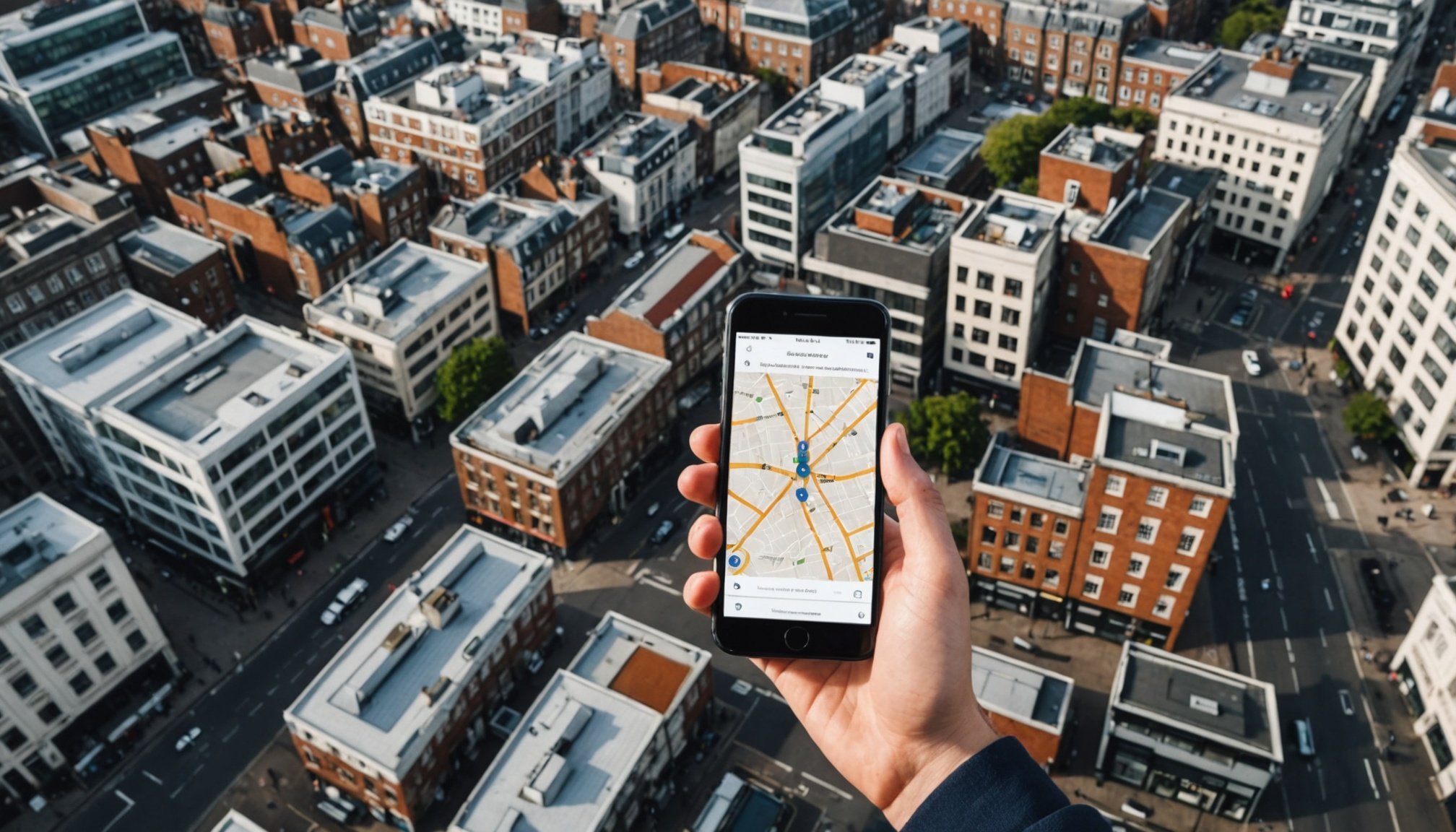Understanding Geofencing Technology
Geofencing is a dynamic technology that uses GPS or RFID to create a virtual boundary around a specified geographic area. When a mobile device enters or exits this area, pre-programmed actions can be triggered. This technology has gained traction, especially within location-based marketing.
Unlike traditional marketing techniques, geofencing offers a more tailored approach. By focusing on a specific area, businesses can send tailored messages and advertisements to potential customers who are nearby. This ensures higher engagement rates as users receive relevant content precisely when they’re near the point of sale. In contrast, traditional marketing might rely on untargeted broadcasts that risk wasting resources or engaging uninterested audiences.
Additional reading : Transforming uk charities: harnessing ai to elevate donor connection and impact
In the UK market, geofencing is becoming increasingly relevant as companies seek innovative digital marketing strategies. Retailers, event organizers, and even local services utilize this technology to attract customers effectively. For instance, a coffee shop could use geofencing to send special offers to individuals passing nearby, enhancing user experience and boosting sales.
Furthermore, industries like logistics and property management are leveraging geofencing for operational efficiencies, demonstrating its versatility. As digital transformation progresses, geofencing represents a powerful tool in the marketer’s arsenal, appealing to the tech-savvy consumer while offering strategic advantages.
Have you seen this : Ultimate guide to developing a comprehensive social media strategy for uk restaurants: your step-by-step blueprint
Benefits of Geofencing for Local Businesses
Geofencing offers remarkable advantages for local business marketing, particularly in enhancing customer interactions. By establishing virtual perimeters around specific locations, businesses can deliver targeted advertising to individuals within those areas, thus significantly increasing customer engagement.
One of the primary benefits is the ability to offer personalized experiences. For example, when a potential customer enters a geofenced area, they could receive notifications about special promotions or events tailored to their interests. This targeted approach resonates more with consumers, increasing the likelihood of a positive interaction.
When comparing geofencing to traditional broader marketing strategies, it proves more cost-effective. Instead of spending large sums on expansive campaigns with generalized reach, geofencing allows businesses to allocate resources directly to areas with potential customers, optimizing the return on investment.
Furthermore, this approach leads to enhanced targeting that often results in higher conversion rates. By focusing efforts on a localized audience already in close proximity, businesses can attract and convert foot traffic more effectively. Ultimately, leveraging geofencing enables local businesses to refine their marketing strategy, ensuring that their messages are both relevant and impactful, driving increased success in their marketing efforts.
Implementing Geofencing Tactics
Geofencing is a dynamic tool in the realm of digital marketing tactics. When executed thoughtfully, it can enhance your strategic planning efforts. This section delves into the actionable steps needed for a successful geofencing implementation strategy.
Identifying Key Locations
Choosing the right locations is pivotal in geofencing implementation. Start by analyzing your target market to identify key locations where your audience frequently visits. Think about places where they shop, dine, or relax. Use data analytics tools to glean insights into customer behaviour patterns, ensuring that your geofencing areas are strategically beneficial and yield the highest engagement.
Setting Up Geofences
Once key locations are identified, the next step is setting up geofences. This involves selecting geographic boundaries around your chosen areas. Use digital maps and GPS technology to define precise perimeters. For instance, if targeting a retail park, create geofences around individual stores or the entire park. Test the accuracy of these perimeters for optimal results, ensuring minimal interference from irrelevant locations.
Integrating with Marketing Platforms
Integration with marketing platforms is crucial for geofencing implementation. By linking your geofences with systems like Google Ads or social media advertising tools, you can deliver targeted campaigns seamlessly. This integration amplifies your marketing tactics, allowing for real-time engagement with potential customers as they enter your geofenced areas.
Case Studies and Success Stories
Geofencing has proven to be a game-changer for local businesses seeking tailored marketing strategies. Across the UK, there are numerous geofencing case studies highlighting significant success. One compelling example is a local restaurant chain that used geofencing to target potential customers within a one-mile radius. By sending timely promotions during lunch hours, they increased foot traffic by 30% in just three months.
Similarly, a retail store in Manchester leveraged geofencing to alert nearby customers about flash sales. This approach resulted in a 25% boost in store visits, underscoring the effectiveness of marketing examples tailored by location and time.
Analysing these campaigns, the outcomes reveal several best practices. First, precise targeting is essential. Businesses need to ensure the parameters set for geofencing align accurately with their target audience. Additionally, crafting relevant, engaging messages ensures customers are motivated to take action.
From these examples, lessons learned include the importance of ongoing analysis and iteration. Campaigns should be continuously refined based on real-time data to maximize impact. Understanding the local business success stories enables businesses to adapt these strategies to their unique needs, ensuring they not only attract new customers but also foster loyalty among existing ones.
Measuring ROI and Effectiveness of Geofencing
Evaluating the performance of geofencing campaigns involves tracking several key performance metrics. Identifying relevant Key Performance Indicators (KPIs) such as customer engagement, conversion rates, and footfall can determine success. For accurate analysis, maintaining metrics that illustrate progress is essential. Tools like marketing analytics platforms serve as valuable resources to track these metrics.
Marketing analytics help in deciphering complex data into actionable insights. They provide a comprehensive understanding of user behavior by tracking ROI. Knowing which metrics to follow enables businesses to enhance their strategies and boost performance.
Tracking ROI in geofencing entails understanding the balance between costs and benefits. Businesses should aggregate data on expenses and the resultant gains from the campaign. This analysis assists in determining if the investment in a geofencing strategy is viable. By effectively measuring ROI, companies can deduce the effectiveness of their marketing analytics and campaigns.
Analyzing cost versus benefits offers valuable insights into understanding whether geofencing is benefiting the business in monetary terms. Employing these methods can streamline processes, maintain the performance of campaigns, and guide decision-making. Overall, this approach fosters an environment for successful and sustainable geofencing strategies, prioritizing precision in measuring their outcomes.
Future Trends in Geofencing and Local Marketing
The future of geofencing is transforming with rapid technological advancements influencing marketing trends and location-based advertising. New algorithms are enabling geofencing to become more precise, providing businesses strategies to target consumers at the exact location and timing. Enhanced data analytics allow marketers to decipher consumer behavior patterns and adapt real-time campaigns accordingly.
Local businesses are poised with both opportunities and challenges. On one hand, advanced geofencing enables them to personalize marketing, attract foot traffic, and enhance customer engagement. However, they must tackle privacy concerns and ensure compliance with regulatory frameworks, particularly the General Data Protection Regulation (GDPR) in the UK. Adopting state-of-the-art security measures will be crucial in maintaining consumer trust.
Predictions for geofencing in UK marketing strategies highlight an increase in location-based advertising integrating augmented reality (AR) to craft immersive experiences. As consumers demand frictionless interactions, businesses will invest in seamless technologies that blend online and offline experiences. Moreover, increased collaboration with tech companies can accelerate innovation in geofencing applications.
Fostering partnerships and embracing cutting-edge technology will allow businesses to leverage the evolving landscape of geofencing efficiently. Remaining agile and proactive, businesses will thrive in a competitive market by capitalizing on the technological advancements shaping the future of geofencing.











